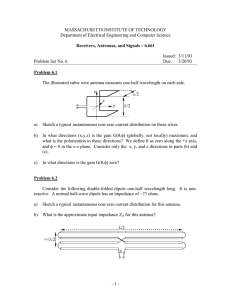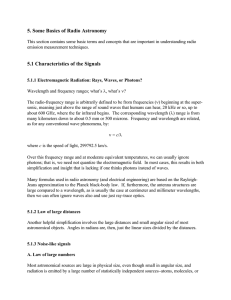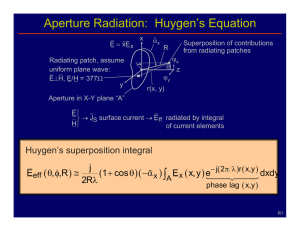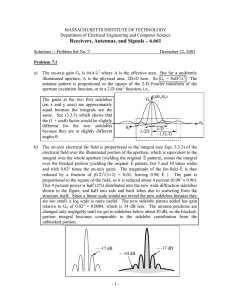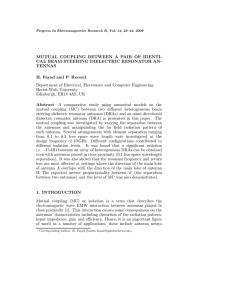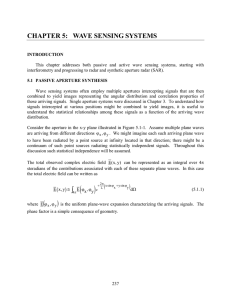MASSACHUSETTS INSTITUTE OF TECHNOLOGY Department of Electrical Engineering and Computer Science Issued:
advertisement
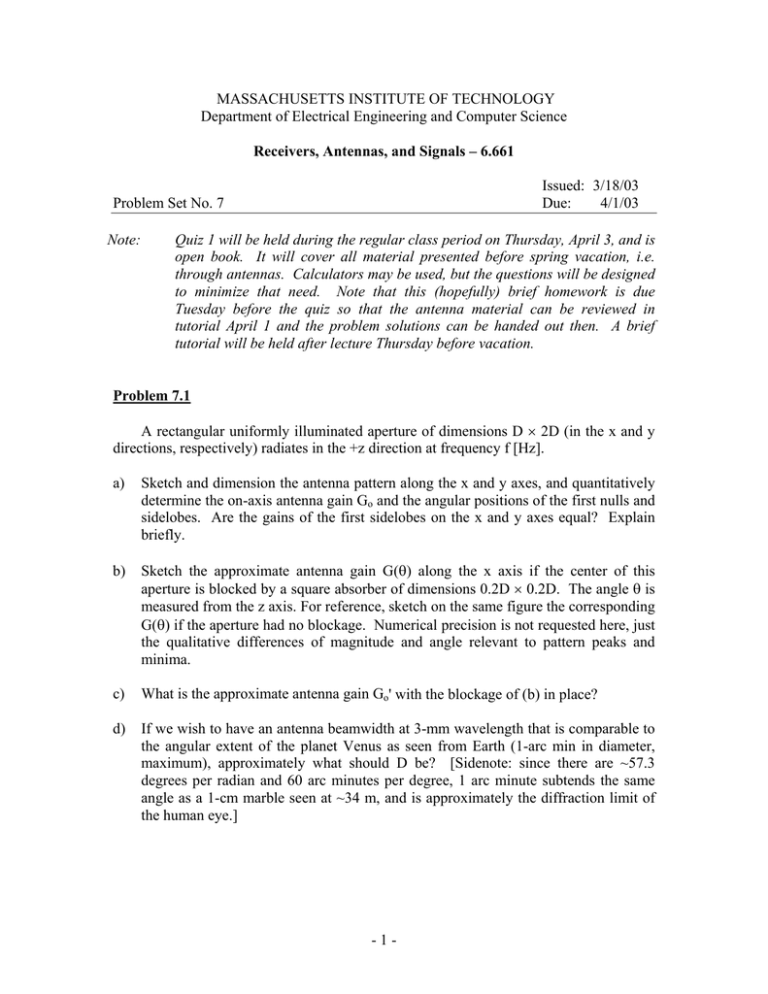
MASSACHUSETTS INSTITUTE OF TECHNOLOGY Department of Electrical Engineering and Computer Science Receivers, Antennas, and Signals – 6.661 Issued: 3/18/03 Due: 4/1/03 Problem Set No. 7 Note: Quiz 1 will be held during the regular class period on Thursday, April 3, and is open book. It will cover all material presented before spring vacation, i.e. through antennas. Calculators may be used, but the questions will be designed to minimize that need. Note that this (hopefully) brief homework is due Tuesday before the quiz so that the antenna material can be reviewed in tutorial April 1 and the problem solutions can be handed out then. A brief tutorial will be held after lecture Thursday before vacation. Problem 7.1 A rectangular uniformly illuminated aperture of dimensions D × 2D (in the x and y directions, respectively) radiates in the +z direction at frequency f [Hz]. a) Sketch and dimension the antenna pattern along the x and y axes, and quantitatively determine the on-axis antenna gain Go and the angular positions of the first nulls and sidelobes. Are the gains of the first sidelobes on the x and y axes equal? Explain briefly. b) Sketch the approximate antenna gain G(θ) along the x axis if the center of this aperture is blocked by a square absorber of dimensions 0.2D × 0.2D. The angle θ is measured from the z axis. For reference, sketch on the same figure the corresponding G(θ) if the aperture had no blockage. Numerical precision is not requested here, just the qualitative differences of magnitude and angle relevant to pattern peaks and minima. c) What is the approximate antenna gain Go' with the blockage of (b) in place? d) If we wish to have an antenna beamwidth at 3-mm wavelength that is comparable to the angular extent of the planet Venus as seen from Earth (1-arc min in diameter, maximum), approximately what should D be? [Sidenote: since there are ~57.3 degrees per radian and 60 arc minutes per degree, 1 arc minute subtends the same angle as a 1-cm marble seen at ~34 m, and is approximately the diffraction limit of the human eye.] - 1 - Problem 7.2 Show, using determinants, whether or not the following set of four antennas can measure all four Stokes parameters: [right-circular, left-circular, y-polarization, and 45degree linear polarization]. Problem 7.3 A very large optical telescope (λ ≅ 0.5×10-6) consists of randomly positioned small mirrors that all focus on the same spot; they are segments of a perfect parabolic reflector. They are positioned such that the resulting aperture autocorrelation function φE(τ) can be approximated by an ~impulse near the origin of half-power width d, where d is the diameter of each little mirror, and a plateau of much lower amplitude of half-power width D, where D is the diameter of the region over which the little mirrors are scattered. What is the angular resolution of this telescope for the case where d = 10 cm and D = 100 meters? Under what circumstances might this be a practical approach to telescope building? (Speculate). Problem 7.4 A 20-cm optical telescope transmits 0.6-micron wavelength signals toward a geostationary satellite, but its mirror has small rms surface errors σo [m] of lateral scale length ~1 cm that dominate the mirror sidelobe levels. a) Approximately what value of σo yields on-axis gain reductions of ~1 dB? b) Approximately what is the maximum value of σo that will yield near-sidelobe levels more than 30 dB below the main lobe? c) If this telescope suffers from 1-dB losses at 1-micron wavelength, what is the shortest wavelength at which this telescope is probably useful? Assume that at this shortest “useful” wavelength the on-axis gain losses relative to perfect illumination are ~6 dB [~factor of four]. - 2 -
